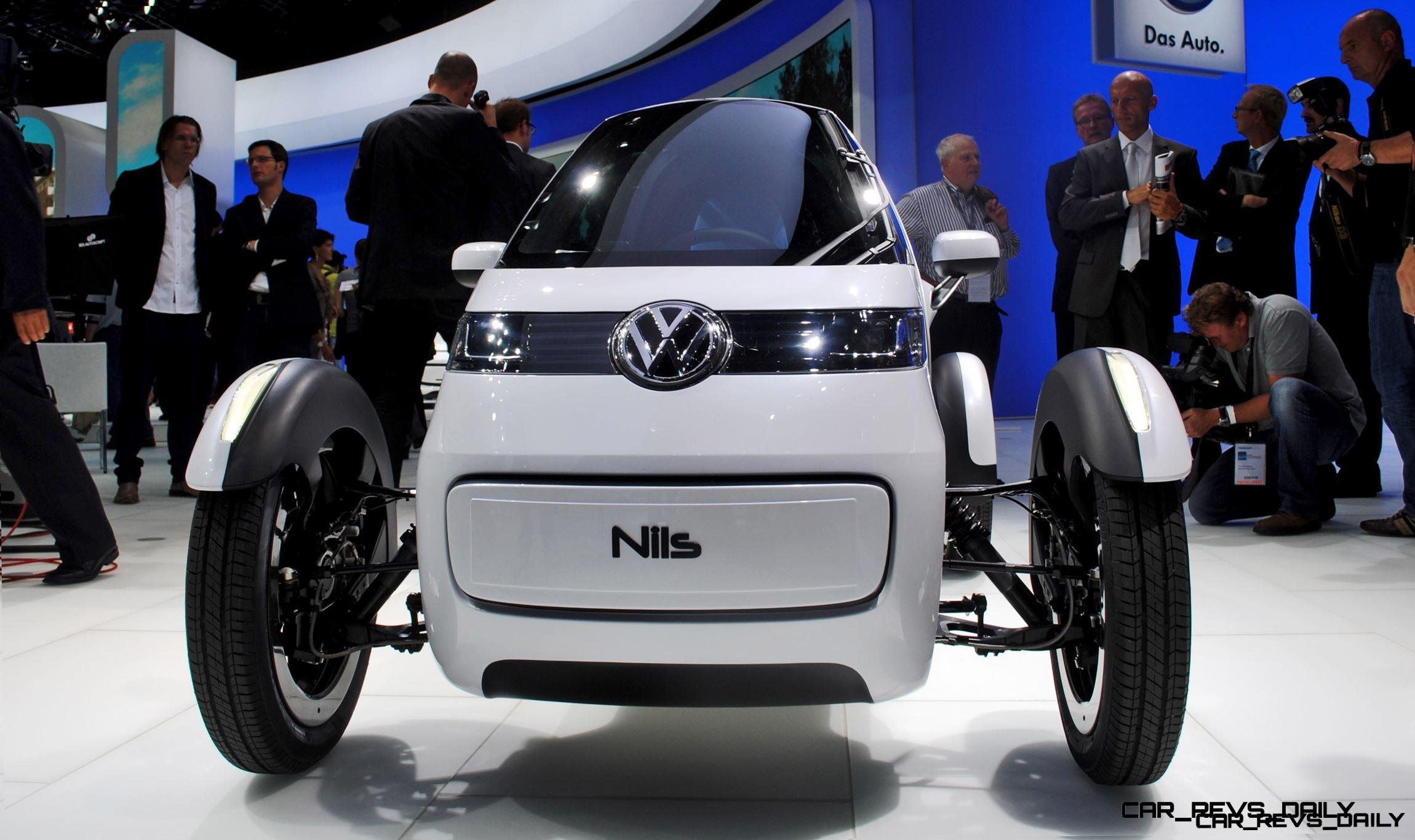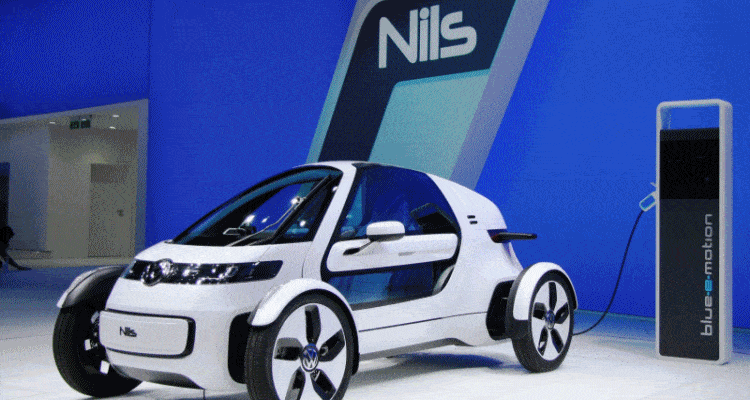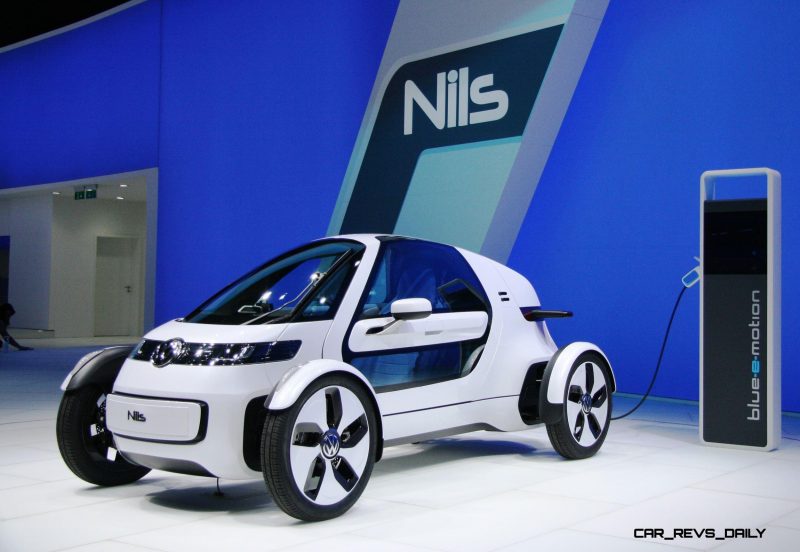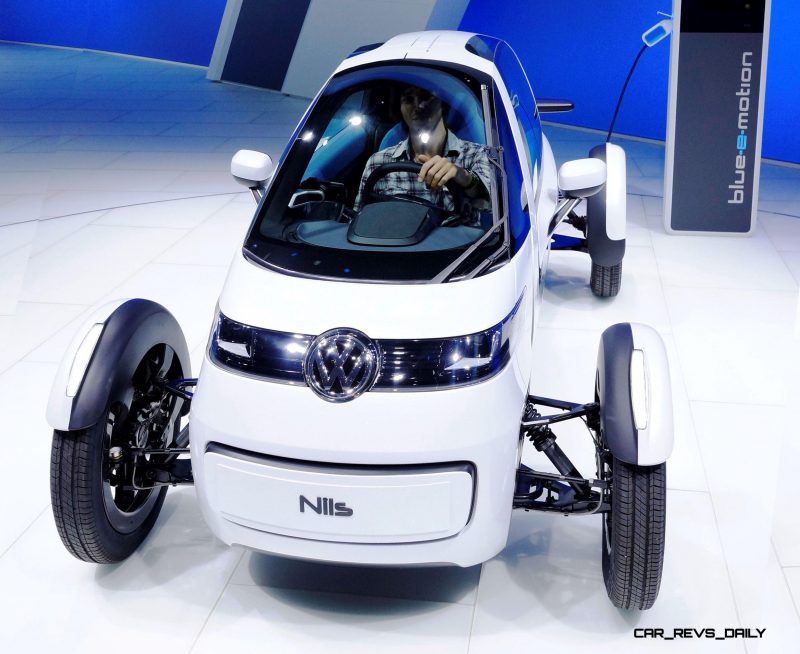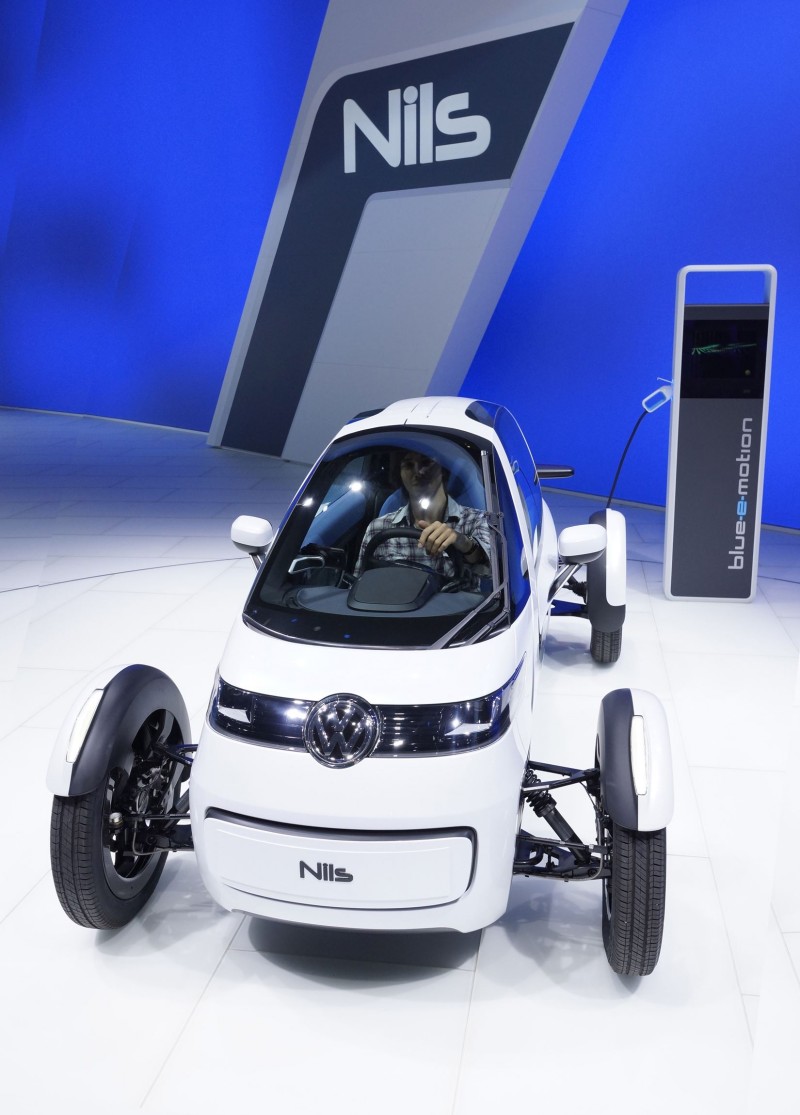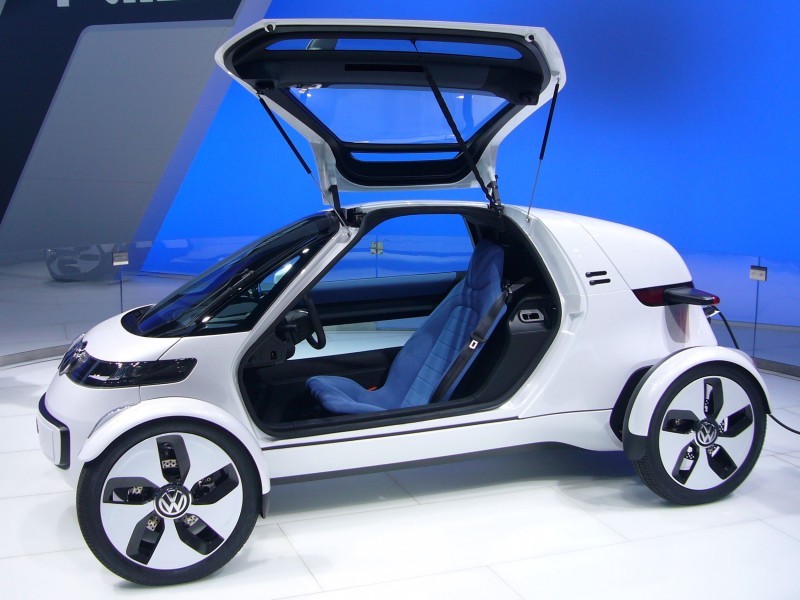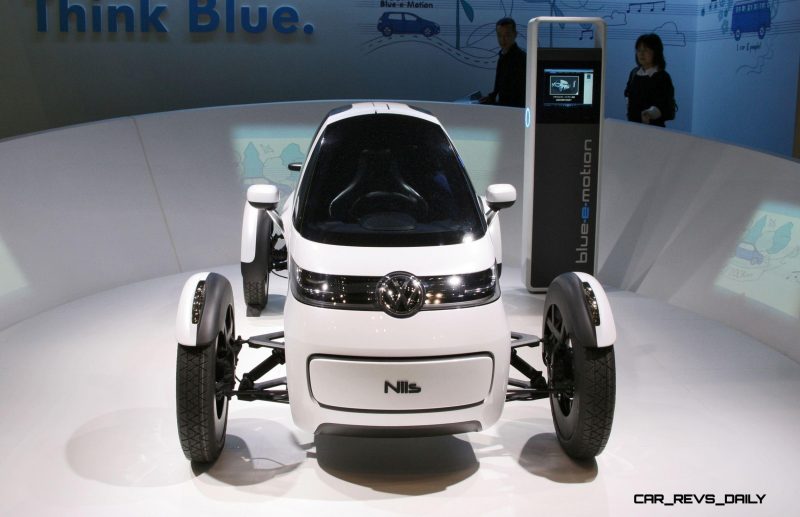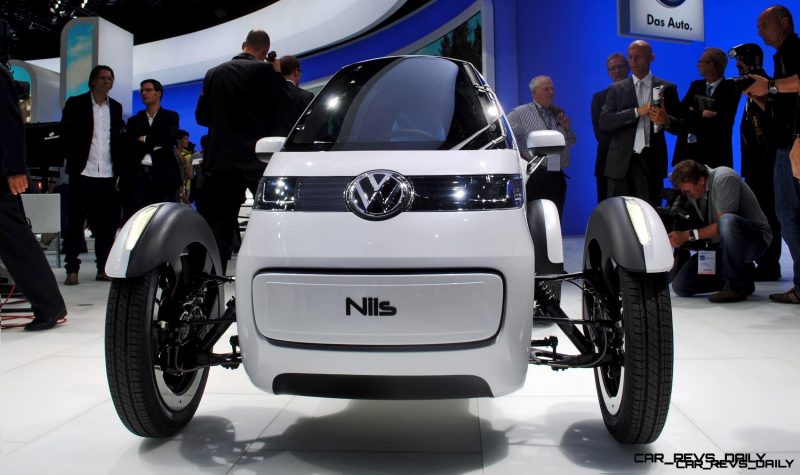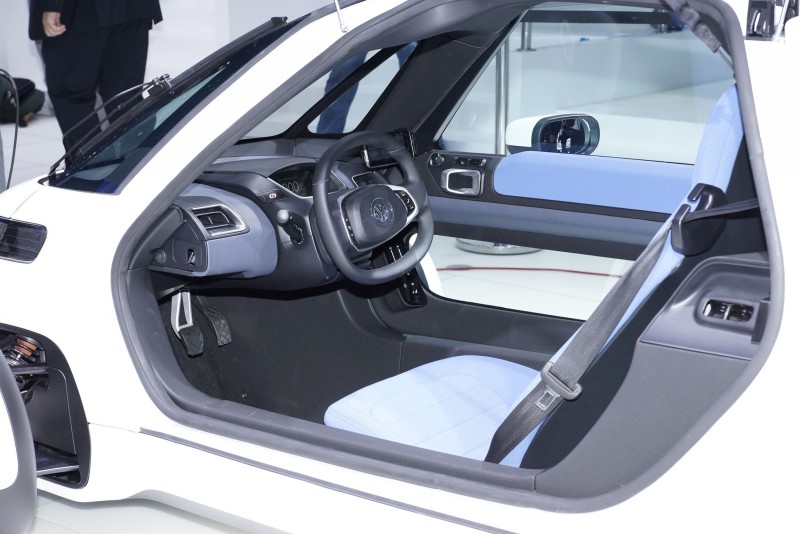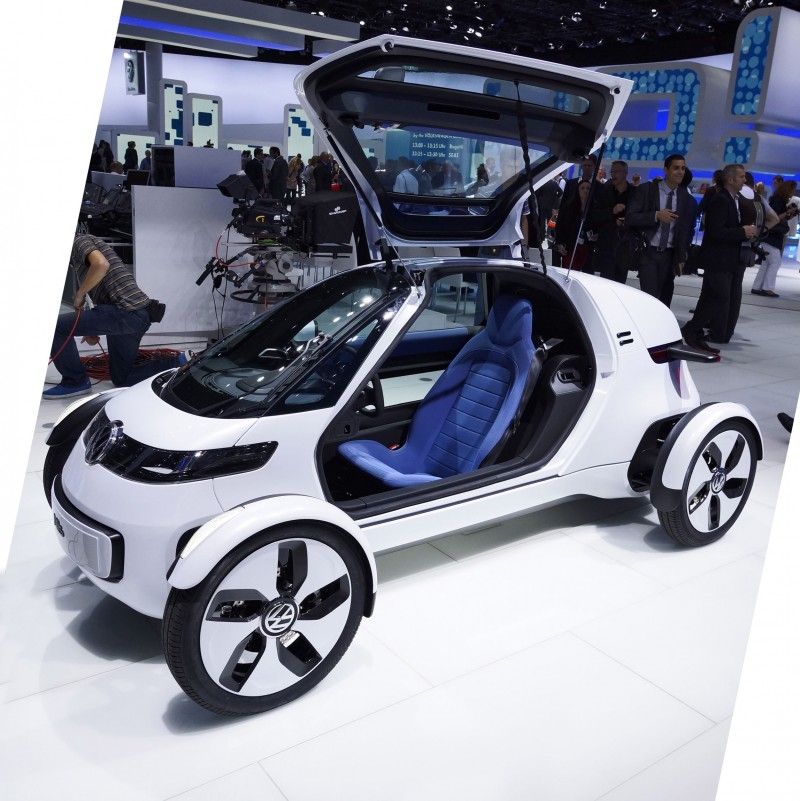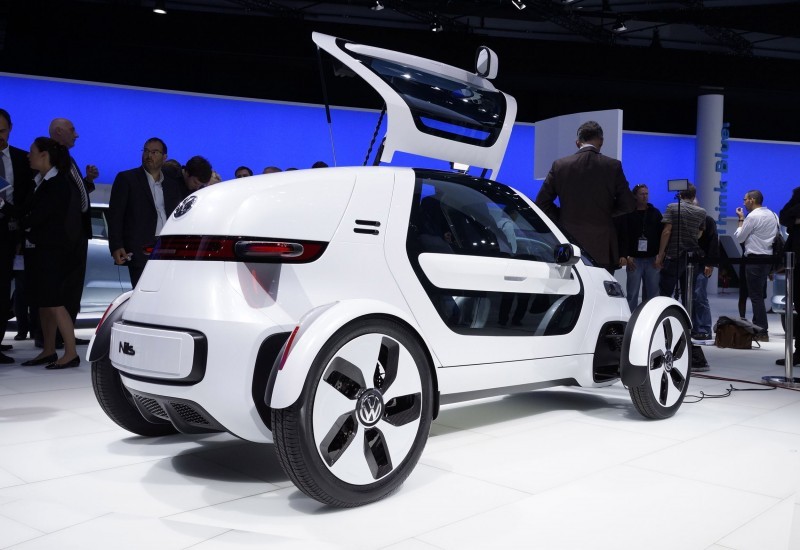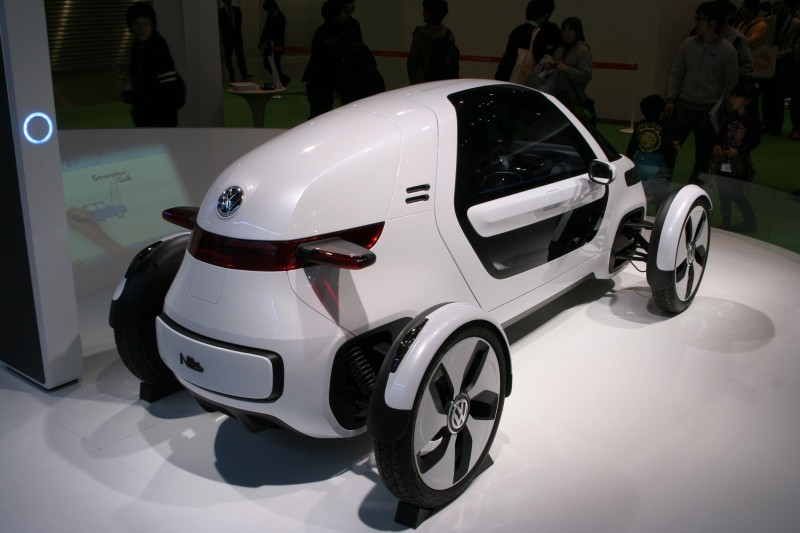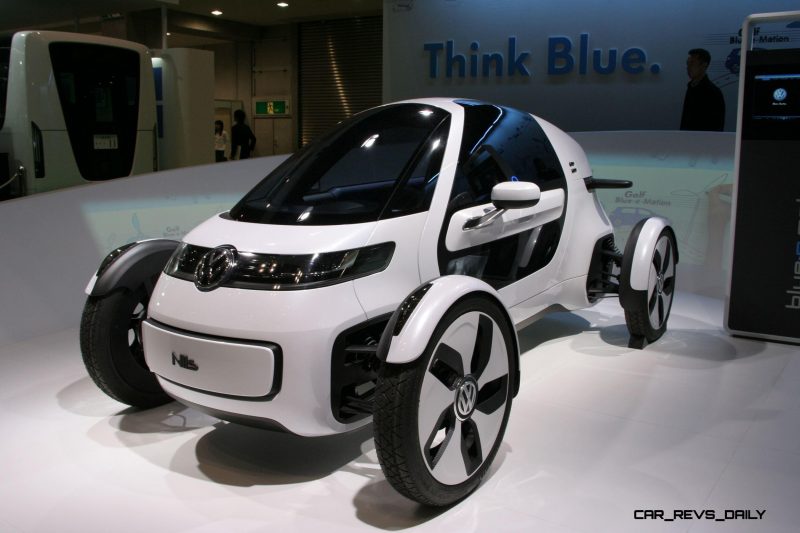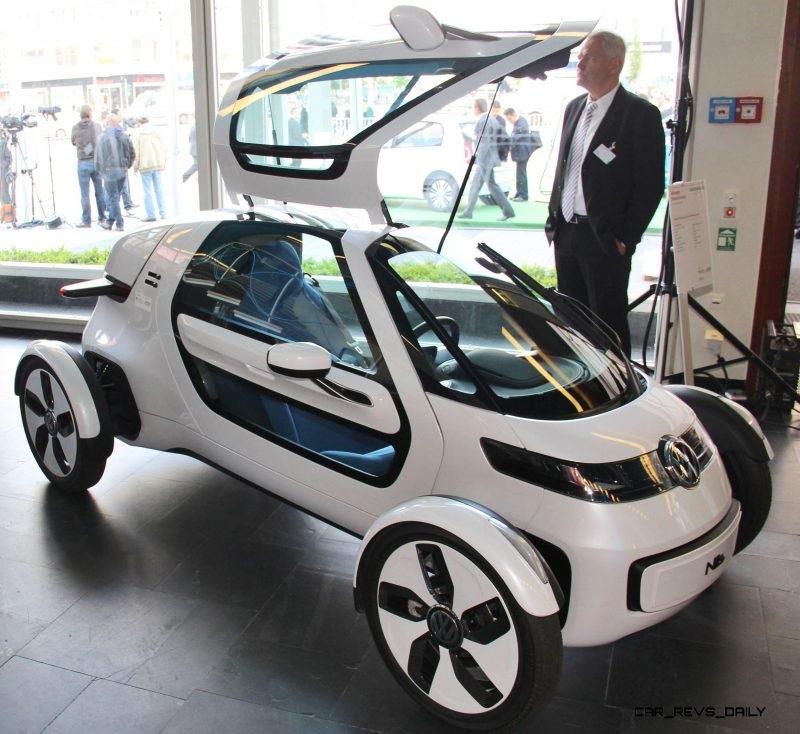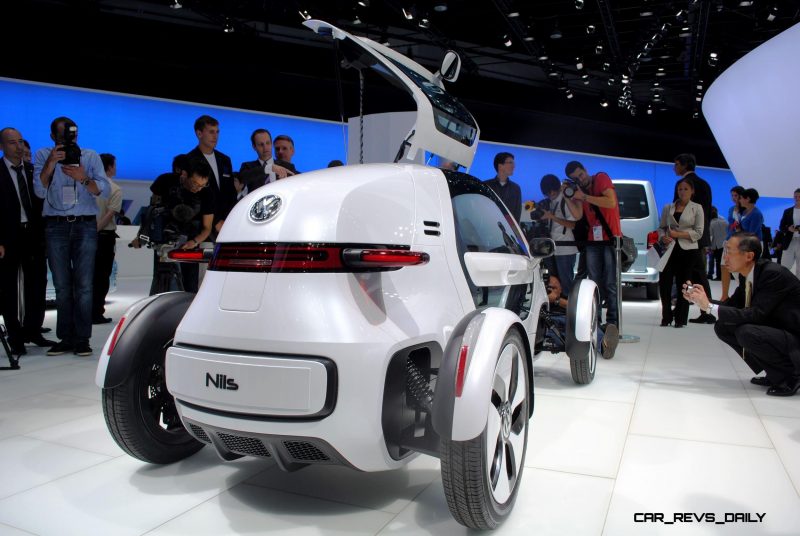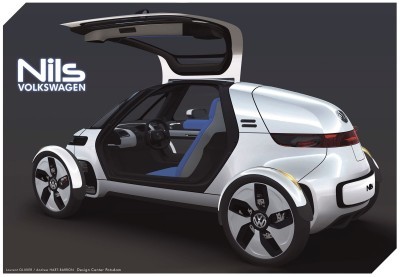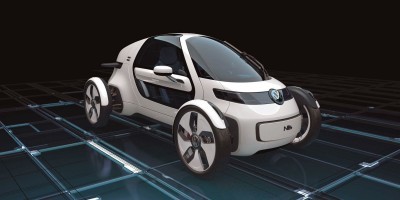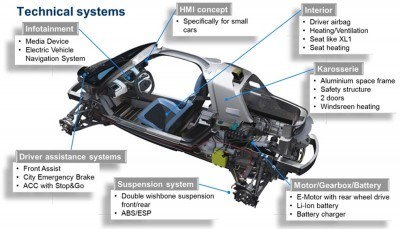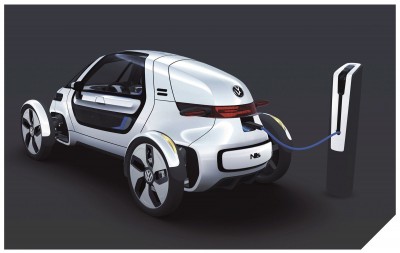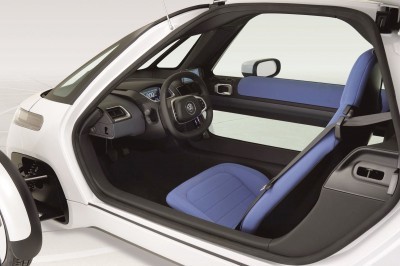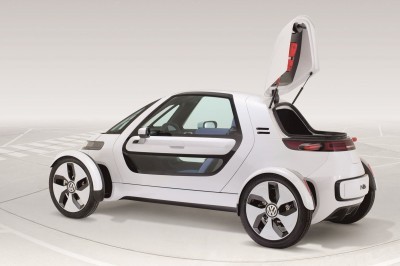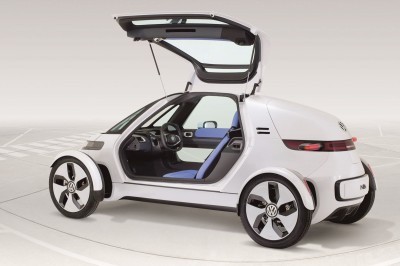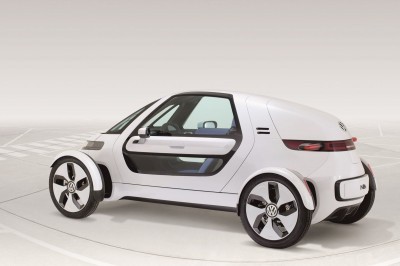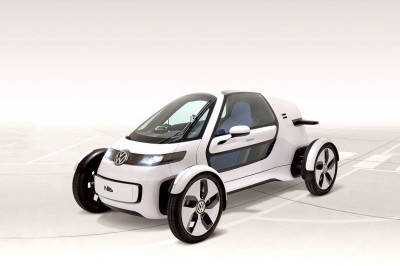It is very, very challenging to read (and write) about VW’s eco mobility ideas in light of the company’s current emissions scandals.
The “diesel issue” — as it is known in German — really puts all the last ten years of innovative, visionary concept cars in the shameful, punishment corner of the automotive universe. What about the “C02 issue”? Oh, that has resolved itself. Not a pattern of lies and systemic fraud. Hooray!
Super, super trustworthy company, obviously.
Beyond that obligatory caveat… This NILS concept shows how seriously the VAG once took its mission to mass-produce zero-emissions automobiles.
VW was actually up to some clever things until they realized they could just cheat instead.
Take this NILS concept for example. A single-seat commuter car with the electric drive motor in back and absolutely tiny dimensions, the NILS promised about 44-miles of range and a top speed of about 75-mph. The NILS supposedly meets real-car crash tests, which would have theoretically made it road-legal worldwide.
Alas, the vehicle was not green-lit for production. The last painful irony? The NILS concept was underwritten by the pushovers and yes-men of the Federal Ministry of Transport. What a joke. Lip-service and greenwashing to the core, this NILS.
Sidebar: The German Federal MoT is now known… get this… as the Ministry of Transport and Digital Infrastructure. Guffaw.
Of course, the devil’s advocate might say, ‘Renault made a car like this for London in the Twizzy… and the car has been a total market failure.’
Yes, you would be right. But in terms of brand affinity, Renault now seems like a huggable friend versus cold, calculating VW. Criminal Conspiracy is all that comes to mind when delving into VW lately.
To close this rant: NILS as a name for this concept seems like a dark joke, referencing its chances for production: Nil.
2011 Volkswagen NILS
Wolfsburg / Frankfurt, 13 September 2011
NILS – World Debut at the IAA
Volkswagen presents high-tech single-seater:NILS travels like an arrow into the urban future
The 460 kg lightweight single-seater with electric drive was specially designed for commuters
NILS research project is supported by Federal Ministry of Transport
Volkswagen AG is presenting a car for the urban world of tomorrow at the 64th International Motor Show (IAA) in Frankfurt: NILS. The single-seat electric vehicle reflects a new, fascinating form of minimalist mobility. The concept car – with its pro-gressive aluminium space frame, wing doors and free-standing wheels – exhibits a high level of dynamic performance, yet travels with zero emissions and silently towards the future. The project is supported by the German Federal Ministry of Transport, Building and Urban Development.
Technically realistic and economically supportable. “NILS is a vehicle that anticipates the future. It looks as though someone had projected it back from the year 2030 to the world of today. This study melds sustainability, design and lifestyle in a new way. A high-tech vehicle from the Volkswagen company with an electric drive, but very realistically conceptualised,” says Dr. Ulrich Hackenberg, member of the Board of Management and Head of Development for the Volkswagen Brand. Prof. Dr. Jürgen Leohold, Director of Volkswagen Group Research explains the project from the research perspective: “In the context of the growing influence of electric mobility, cutting edge vehicle concepts like these – which are based on intensive analyses of future and vehicle research and on strong networking ties to Marketing – will play an increasingly important role. That is because new, very target group specific requirements will be placed on cars with the advent of electric mobility. These new vehicle concepts – together with the electrification of existing models – will help to advance electric mobility to a breakthrough.” In this context, Dr. Ulrich Hackenberg explains further: “The goal of the NILS project is to work out a technically concrete and economically feasible vehicle concept for micromobility, which restructures individual transportation to make it more efficient and environmentally compatible based on electric drive technology.” Prof. Dr. Jürgen Leohold adds: “Therefore, Group Research intensively analysed all facets of commuter transportation with the goal of making it sustainable for the future. The results of these analyses were made available to individual vehicle development departments. And so, all of the company’s brands – from A for Audi to V for Volkswagen – are benefiting from the think tank of Group Research.
“Networked know-how. Dr. Ulrich Hackenberg comments, member of the Board of Management of the Volkswagen Brand for Development: “The close cooperation with Group Research has meant that we at Volkswagen are really able to put cutting-edge vehicle projects in motion. We benefit from the networked know-how of the company here. This also includes the Volkswagen Design Centere in Potsdam. There, under the leadership of Thomas Ingenlath, an entirely new interpretation of Volkswagen design was accomplished in NILS. Those viewing this concept car can look far into the future of our brand and of the automobile itself. NILS is anything but a dry-run exercise; it is very realistic. Despite its compact dimensions, the concept fulfils all safety requirements for contemporary vehicles, for example. Commuters would not only drive in an eco-friendly way, but would also be very safe in this car.
“With a range of 65 kilometres, the 130 km/h NILS would certainly be the ideal vehicle for the majority of commuters in Germany. According to the German Federal Statistical Office, 73.9 per cent of all commuters residing between Berlin and Munich cover less than 25 kilometres on their way to work. So, NILS is designed to be a reflection of a new era.
NILS defines new segment
Electric traction changes mobility. Automobiles have always been mirrors of the times with their design styles and technological standards always reflecting the status quo of a particular era. Consider Volkswagen: at the turn of the century, the age of downsizing gained momentum in the powertrain area. At the same time, a new quality of styling took hold, which today is still marked by maximum clarity and precision. Currently, we are experiencing yet another developmental thrust: the long-term breakthrough of electric traction. Many Group models in the higher vehicle classes are already available with hybrid drives, where the electric motor supports the conventional drive system. This emissions-reducing drive technology is now breaking into high-volume segments.
Golf with E-drive debuts in 2013. TThe first high-volume models with a pure electric drive will soon reach production readiness; the Golf, the best-selling car in the world, will debut with an electric drive (Blue-e-Motion) in 2013. In addition, electric traction will lead to entirely new concepts; they will result in vehicles that fulfil specific needs profiles more than ever. One of these needs profiles is that of the commuters who commute to their jobs by the millions every day in the world’s urban areas. For a long time now, public transportation has not always been the first choice of commuters for various reasons. In Germany, for example, about 60 per cent of all commuters travel by car according to the Federal Statistical Office; of these, over 90 per cent travel alone. Zero emissions vehicles like NILS will offer these frequent drivers a new eco-friendly mobility solution.
NILS leaves a small footprint in traffic
Narrower, lower, shorter, different. The concept is a very compact car that requires extremely little space in traffic. NILS is only 3.04 metres long, making it about 50 cm shorter than the new Volkswagen up! The width of the NILS, from wheel to wheel, is 1.39 metres; the body itself measures only 0.86 metres wide. The concept car is 1.2 metres tall. By means of comparison: a Porsche 911 is taller at 1.31 metres.
Design was created in Potsdam. More important than its dimensions is the layout of its body. NILS shares the same basic body layout as a Formula-1 race car body: driver in the middle, engine in back, aluminium wheels outboard and free-standing. The 17-inch alloy wheels are equipped with 115/80 (front) and 125/80 (rear) tyres optimised for low rolling resistance. The clean, distinctive styling of the NILS car has its origins at the Volkswagen Design Centre in Potsdam, just near the gates of Berlin. Designer Thomas Ingenlath, the centre’s director, comments on the research vehicle: “NILS was designed to make a visual statement and transport a vision of the automotive future to the present. The car had to visually highlight the theme of sustainability, on the one hand, while showing a future-oriented look and simply being fun. I think that we have successfully integrated both of these aspects. Although our mission here was to come up with an entirely new body concept for the brand, NILS matches the Volkswagen design DNA 1:1.” Consider the bumpers: it is no coincidence that they remind one of the bumpers on the new up! with their black borders around the impact surfaces. Thomas Ingenlath continues: “I am especially pleased that we managed to implement the concept of the 2 glass wing doors. This allowed us to create large transparent surfaces and simultaneously make entering and exiting the vehicle very comfortable, even in the most cramped of parking spaces.”
NILS is tailored to commuting distances
65 km and 130 km/h. Although, or even because, NILS is so compact and lightweight (460 kg), it is a lot of fun to drive. It is an agile car with a top speed of 130 km/h, and it can accelerate to 100 km/h in less than 11 seconds. This is accomplished by an electric motor with a reasonably small 15 kW nominal power and short-term peak power of 25 kW. A lithium-ion battery supplies the electric motor with energy. The battery capacity (5.3 kWh) enables driving ranges of up to 65 km, depending on the style of driving. A battery of this size is relatively inexpensive, and its capacity is sufficient for this type of car. The research vehicle can be charged either via a conventional 230 Volt electrical outlet (maximum charging time 2 hours) or at an electric vehicle charging station. The plug port is located at the back underneath the rear lighting module.
Electric motor is a lightweight 19 kg. In setting up the electric drive system, engineers made use of the great wealth of experience Volkswagen has acquired in developing other concept cars such as the L1 and XL1 as well as future production vehicles like a Golf Blue-e-Motion or up! Blue-e-Motion. The centrepiece of the drive unit is the lightweight 19 kg electric motor together with its transmission and battery. Energy management is via a high-voltage pulse inverter, which – together with the 12 Volt DC/DC converter for the vehicle electrical system and the charger – forms an integral drive unit. It is the rear axle that is driven. All drive unit components are located compactly in an aluminium housing. The unit, including the drive shafts, is integrated at the rear of NILS.
Space for shopping. The motor, battery and all other components are so compact in their construction that there is still space for a small but practical bootspace above the drive unit. As on the Golf, for example, the bootlid is unlocked via the VW logo; in this case, the body-coloured area above the rear lighting module swings upwards. The space is laid out so that users can conveniently stow items from a classic shopping trip – a case of drinks and a bag, for example.
NILS is sporty and agile
Optimal weight distribution. With a vehicle like NILS, the customer target group would not only commute to work with zero emissions, but as described would also have a lot of fun doing it. That is because the lightweight NILS drives like a sports car with its pure mechanical steering and centrally positioned shell seat; from a standstill, the electric motor produces a maximum torque of 130 Nm, which is transferred to the rear axle via a one-speed transmission. For wheel control and suspension, there are double-wishbone suspensions front and rear; the ESP electronic stabilisation programme ensures that with all of its agile performance, NILS will still stay on course. The car’s very good weight distribution between the front and rear axles contributes towards the ESP having to do as little as possible.
NILS brakes and accelerates automatically upon request
Innovative City Emergency Braking. Another important electronic assistant in NILS is City Emergency Braking. The continually active system uses a laser sensor (in the front VW logo) to detect the risk of an imminent collision, and at that moment it automatically brakes the car. Depending on the car’s speed and the driving situation, City Emergency Braking can reduce the speed at impact and might even prevent an accident.
Automatic Distance Control. City Emergency Braking is a software extension of the automatic distance control system (ACC). Its full range of functionality is available in NILS. The ACC system also uses a laser sensor to measure the distance and relative speed to the vehicle ahead in traffic – parameters to which NILS automatically adjusts its speed. Beforehand, the driver preselects the desired following distance and vehicle speed, similar to a cruise control system. The automatic distance control system has intuitive controls with 3 new multifunction keys in the steering wheel. Two arrow keys are used to vary the vehicle speed (in open driving) and the distance to the vehicle in front. Another key between the 2 arrow keys is used to activate or deactivate the ACC system. The system itself can be used over the entire speed range of NILS; in addition, the system can even automatically brake the car to a stop, depending on the situation. Not only are the four disc brakes used to brake; electric traction by electric motor and battery regeneration can be used to brake as well, depending on the driving situation. Last but not least, Front Assist is integrated in the ACC system. This continually active system warns the driver of a potential collision; at speeds below 30 km/h, automatic braking can avoid a collision under some circumstances.
Digital instruments
TFT display as instrument cluster. The instrument cluster was tailored to the electric vehicle. The main surface here is a 7-inch TFT display. The vehicle’s speed is shown digitally in the middle. Energy flow is visually represented by bar elements. Another graphic display offers information on the driving range.
Clever touchscreen. The second central instrument is a mobile multifunctional talent like the one used in a similar form in the new up!: the Portable Infotainment Device (PID). It is snapped onto the A-pillar to the right of the instrument cluster. Via touchscreen, the driver controls functions related to “Navigation”, “Radio”, “Media”, “Telephone”, “Trip computer” and – to preconfigure the driving range – “Eco”. At the start of the drive, the PID computes the expected driving range, then it not only displays the route on the map display, but also the radius and thereby the destinations that can be reached using the current battery charge.
Simple where it makes sense. To save on weight and costs, certain functional elements and controls are operated without electrical assistance. The side mirrors, for example, are adjusted manually, which is not really an inconvenience in an interior that is only 0.61 metre wide. There is no power assistance for steering either; however, this is no problem on a vehicle weighing less than 500 kg. Meanwhile, the heating and ventilation system has fully electronic control. The driver sets the temperature and blower setting via 2 controls in the form of electronic sliders; 2 additional sliders are used for the ventilation flap position (air flow direction) and seat heating. Located to the right of the steering column is the motor start-stop switch; this round, handy switch is also used to select the position of the single-speed transmission (D, N or R).
NILS relies on aluminium space frame body
Safe like a big car. The aluminium space frame body was designed to be a highly effective safety cell. The body-in-white – i.e. the basic structure without add-on parts or glass – is produced from extruded aluminium parts, cast aluminium and sheet aluminium. The roof frame, together with the wing door mounts, a sturdy roll bar behind the driver, the bootspace and the front bulkhead consist of high-strength sheet aluminium. Also extremely sturdy are the extruded aluminium parts; they are used in the area of the side sills, the transverse profiles and the crash-optimised longitudinal profiles (front and rear car sections). The housings for the drive unit and other elements consist of cast aluminium parts. All add-on body parts are made of plastic and aluminium. The front and rear side body parts are manufactured in aluminium. Parts made of high-strength plastic include the bumpers and the trim panels on the side sills.
Wing doors from 3 parts. The 2 wing doors are a work of art in their manufacture. Their frames consist of 3 main elements: an inner section, a crash reinforcement section and an exterior part. When they are closed, they offer optimal crash safety. The door windows are made of lightweight, scratch-resistant, layered polycarbonate. The front window is made of laminated safety glass.
See and be seen. Xenon and LED elements are used for the headlights, rear lights and indicators. In front, 2 bi-xenon modules handle the job of the dipped and main beam headlights. The indicator lights and daytime running lights are implemented as white and yellow LEDs. The daytime running lights are mounted on the front wheel trim panels, and these lights also serve as position lights for parking. In the acrylic glass of the rear lights – which are integrated in the rear section like small wings – the light generated by LEDs is routed via transparent semiconductors. Their electrical power consumption? Minimal. Which is very apropos to electric vehicles.
Notes:
TDI, TSI, DSG and Twincharger are registered trademarks of Volkswagen AG or other companies of the Volkswagen Group in Germany and other countries.

Tom Burkart is the founder and managing editor of Car-Revs-Daily.com, an innovative and rapidly-expanding automotive news magazine.
He holds a Journalism JBA degree from the University of Wisconsin – Madison. Tom currently resides in Charleston, South Carolina with his two amazing dogs, Drake and Tank.
Mr. Burkart is available for all questions and concerns by email Tom(at)car-revs-daily.com.

